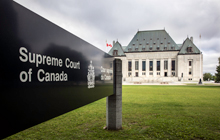Active Asset Management v. The King Case Study

Lorne Saltman of Gardiner Roberts LLP on a recent Tax Court dispute as to whether declared dividends and promissory notes constituted a transfer of property
Case Study: Active Asset Management Inc. v. The King [1]
 |
Lorne Saltman is a Partner with Gardiner Roberts LLP and the Head of the Tax Group. |
In order to prevent a tax debtor from avoiding his/her obligation by transferring assets to a related party, section 160 of the Income Tax Act (Canada) (the “ITA”) provides that if the relevant criteria are met, the transferor and the recipient are jointly liable for the unpaid tax.
Under section 160
Where a person has… transferred property either directly or indirectly, by means of a trust or by any other means whatever, to
(c) a person with whom the person was not dealing at arm’s length,
the following rules apply
(e) the transferee and transferor are … liable to pay under this Act an amount equal to the lesser of:
(i) the amount… by which the fair market value of the property … exceeds the fair market value at that time of the consideration given for the property, and
(ii) the total of all amounts … the transferor is liable to pay under this Act … in respect of the taxation year in which the property was transferred or any preceding taxation year.
The jurisprudence under this section provides that the following four cumulative criteria must be fulfilled in order to impose a transferor’s outstanding tax liability onto a transferee:
(1) The transferor must be liable to pay a tax under the ITA at the time of transfer;
(2) There must be a transfer of property;
(3) The transferee must be a person with whom the transferor was not dealing at arm’s length or to an otherwise designated transferee; and,
(4) The fair market value of the property transferred must exceed the fair market value of the consideration given by the transferee for the property.[3]
In this case, Bakorp Inc. (“Bakorp”) owed CAD$11,983,406.55 in taxes and penalties. Bakorp and its shareholder, Active Asset Management Inc. (“AAM”), resolved to increase the stated capital of its Class A shares and Class B shares by an aggregate of CAD$64,999,999.90, resulting in a dividend being deemed to be paid under the ITA from Bakorp to AAM of the foregoing amount.
In addition, the directors of Bakorp declared dividends on AAM’s Class A shares and Class B shares in the aggregate amount of CAD$77,569,999.90, as evidenced by demand, promissory notes from Bakorp to AAM. Bakorp neither paid the amounts owing, nor did AAM ever demand payment under the promissory notes.
The Canada Revenue Agency assessed AAM for Bakorp’s unpaid taxes on the basis that the deemed dividends and the declared dividends constituted a transfer of property, such that section 160 applied to make AAM liable for Bakorp’s taxes. AAM appealed the assessment.[2]
At the Tax Court of Canada, the main issue was whether there had in fact been a transfer of property from Bakorp to AAM. The jurisprudence under this provision requires that “it is essential that the transferor be divested of his ownership and that the property [vests] in the transferee.[2]
The Court did a careful review of the relevant principles, starting with the nature of dividends. It stated that dividends, when declared and paid, are amounts paid to shareholders as a recognition of a return on their investment in a corporation proportionate to their shareholdings.[3]
The Court then examined the nature of deemed dividends. The Court held that a deemed dividend can occur when there is not a declaration and/or a direct payment or transfer from a corporation to a shareholder. Subsection 84(1) of the ITA outlines the definition and operation of deemed dividends:
(1) Where a corporation resident in Canada has … increased the paid-up capital in respect of the shares of any particular class of its capital stock, otherwise than by
… [not applicable]
the corporation shall be deemed to have paid at that time a dividend on the issued shares of the particular class equal to the amount, if any, by which the amount of the increase in the paid-up capital exceeds the total of
(d) the amount, if any, of the increase referred to in subparagraph 84(1)(b)(i) or the decrease referred to in subparagraph 84(1)(b)(ii), as the case may be,
(e) the amount, if any, of the reduction referred to in paragraph 84(1)(c), and
(f) the amount, if any, of the increase in the paid-up capital that resulted from a conversion referred to in paragraph 84(1)(c.1), (c.2) or (c.3),
and a dividend shall be deemed to have been received at that time by each person who held any of the issued shares of the particular class immediately after that time equal to that proportion of the dividend so deemed to have been paid by the corporation that the number of the shares of the particular class held by the person immediately after that time is of the number of the issued shares of that class outstanding immediately after that time. [emphasis added]
Accordingly, for the purposes of income inclusion under the ITA, if a corporation increases the paid-up capital of a particular class of shares, the corporation will be deemed to have paid to the shareholders of that particular class of shares a dividend. Correspondingly, the shareholders of that particular class of shares will be deemed to have received a dividend from the corporation.
The jurisprudence sets out the purpose of deemed dividends pursuant to section 84 of the ITA:
The purpose of section 84 of the ITA, in general terms, is to deem certain events that are not payments of dividends in corporate law to be payments of dividends for tax purposes.[4]
The Court then analyzed the facts and applied the foregoing legal principles to those facts.
With respect to the deemed dividends, the Court examined whether the shareholder, AAM, was enriched by the deemed dividends, and found that there was no tangible change in the number of shares held by AAM. While AAM could assert that its shares reflected a different stated value, no funds had actually been received by AAM to constitute a true enrichment.
Similarly, the Court found that the deemed dividends did not impoverish Bakorp, as it paid no funds to AAM. AAM had the same number of shares, it simply had a revised notional value.
In addition, when looking at the purpose for the mischief targeted by section 160, the avoidance of payment of a tax debt, this action had also not occurred. The funds available to Bakorp did not change as a result of the deemed dividends.
As far as the declared dividends are concerned, counsel for the government argued that the following facts constituted hallmarks of a transfer of property from Bakorp to AAM:
(i) the delivery of the promissory notes payable on demand which demand may be asserted on the date of making;
(ii) the recording of the declared dividend as taxable and payment of the tax by AAM; and,
(iii) the assumption by Bakorp of the obligation reflected by the promissory notes.
The court definitively dismissed these arguments as a transfer of property. The promissory notes were merely evidence of debt. Their very existence belies that any payment of cash or transfer of assets in kind (securities, bonds or even shares) occurred. Subsequent payments, once made, factually denote transfers of property. The fact that the promissory notes exist is emblematic that no such payment or transfer of property has been made. Similarly, the promissory note is not payable until demand is made. Demand has not been made. Even then, upon such demand and presentment being made, no transfer would occur until payment, in cash or in kind, actually occurs.
The accrual and recording of the declared dividend constitutes an income payment for purposes of the ITA, but does not constitute an actual payment of funds from Bakorp to AAM.
In relation to the mischief targeted by section 160, the Court held that Bakorp did not transfer or surrender control over its assets in order to circumvent the payment of its tax liability.
In conclusion, the Court provided a clear path for analysing the facts of the case and interpreted the relevant section with its anti-avoidance purpose in mind. The Court found that the actions taken by the taxpayers neither constituted an actual transfer or property, nor did the taxpayers conduct themselves so as to defeat or undermine the rationale for the anti-avoidance rule. Accordingly, the AAM’s appeal was allowed in full.
FOOTNOTES
[1] 2024 TCC 87.
[2] Tetrault v. HMQ 2004 TCC 332, at paragraph 39.
[3] Neuman v. MNR [1998] 1 SCR 770 at paragraph 64.
[4] McClarty Family Trust v. HMQ 2012 TCC 80.
Lorne Saltman is a Partner with Gardiner Roberts LLP and the Head of the Tax Group.











(0) Comments